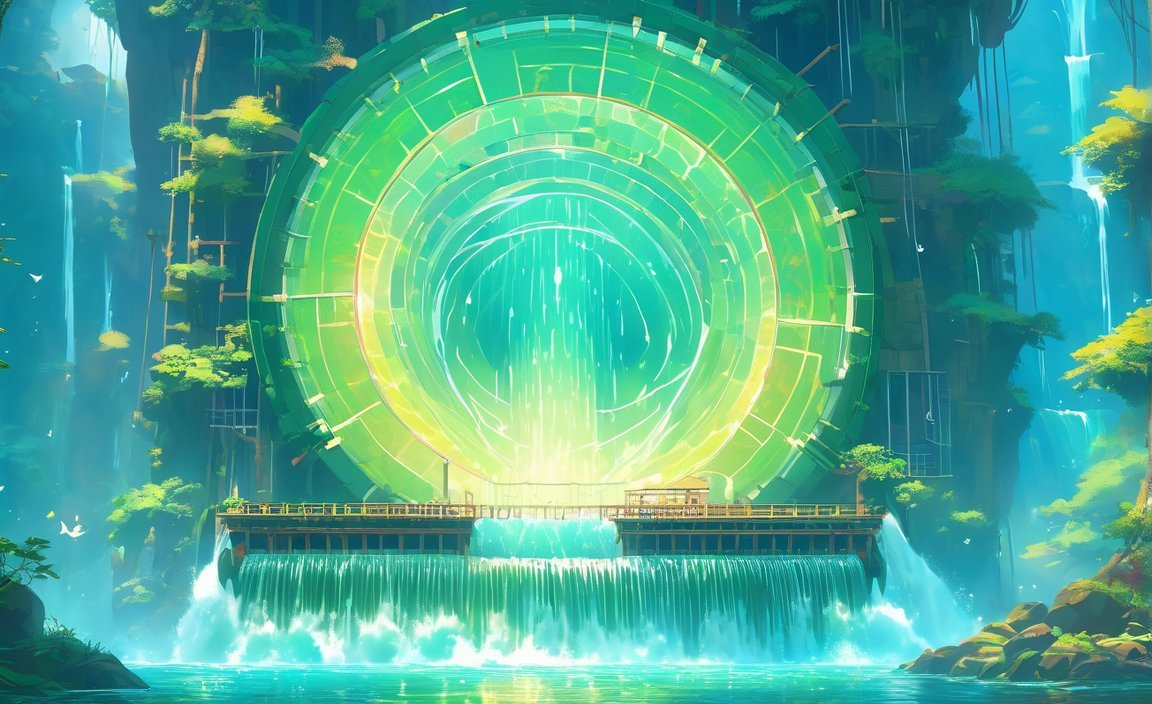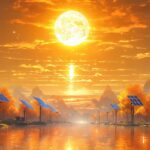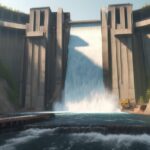Exploring Hydroelectricity: 10 Essential Facts
Hydroelectricity, a renewable energy source that harnesses the power of water to generate electricity, is intriguing in both its simplicity and its ability to revolutionize our energy landscape. In this article, we delve into the realm of hydroelectricity, highlighting ten crucial facts that shed light on its significance and potential. From its origins and environmental benefits to its challenges and technological advancements, we aim to provide a comprehensive overview of this fascinating form of sustainable energy. So, let’s embark on this informative journey and unlock the captivating secrets of hydroelectricity.
Key Takeaways:
- Hydroelectricity is electricity generated by the power of water.
- The cost of hydroelectricity is 5 cents per Kwh.
- Hydroelectricity was first used to grind corn in prehistoric times.
- China is the biggest producer of hydroelectricity, while the USA is the smallest producer.
- Hydroelectricity is produced in 150 countries.
- Hydroelectricity accounts for 16% of total global consumption.
- Hydroelectric dams use fish ladders and elevators for fish migration.
- Hydropower is cost-effective.
- Hydropower is one of the cleanest sources of energy.
- Hydropower is more efficient than fossil fuel.
10 Facts About Hydroelectricity

As we venture into the world of renewable energy, one source takes us back to the powerful force of water – hydroelectricity. Harnessing the energy of flowing water, hydroelectricity has long been recognized as a sustainable and reliable option. Let’s explore 10 key facts about hydroelectricity that shed light on its history, benefits, and significance.
Fact #1: Electricity Powered by Water
Hydroelectricity is simply electricity generated by the power of water. By capturing the kinetic energy of moving water, we can convert it into electrical energy, powering homes, cities, and entire countries. It’s a fascinating way to harness one of nature’s most abundant resources.
Fact #2: Affordability at Its Core
When it comes to cost, hydroelectricity shines. Compared to other energy sources, the cost of hydroelectricity is incredibly low, averaging around 5 cents per kilowatt-hour (KWh). This affordability makes it an attractive option for both consumers and businesses alike.
Fact #3: A Historic Beginning
Did you know that hydroelectricity has roots deep in history? Prehistoric communities were the first to utilize hydroelectricity, harnessing it to grind corn and perform other essential tasks. This ancient use showcases the timeless appeal and practicality of this renewable energy source.
Fact #4: China Takes the Lead
When we talk about hydroelectricity production, one country rises above the rest. China is the largest producer, with an impressive capacity of 22,500 megawatts (MW). This significant figure represents the country’s dedication to clean energy and their recognition of hydroelectricity’s immense potential.
Fact #5: A Global Presence
Hydroelectricity is not limited to a few select nations. In fact, it is produced in 150 countries worldwide, highlighting its widespread adoption as a renewable energy source. From the largest hydroelectric plants to smaller-scale projects, this clean energy solution is making its mark across the globe.
Fact #6: A Slice of the Energy Pie
Hydroelectricity plays a crucial role in the global energy landscape, accounting for approximately 16% of the total energy consumption worldwide. Its contribution is significant, especially as we strive to reduce reliance on fossil fuels and mitigate the impacts of climate change.
Fact #7: A Home for Fish
Hydroelectric dams are designed with more than just energy production in mind. They also prioritize conservation by incorporating fish ladders and elevators, enabling fish to migrate through the dam and reach their spawning grounds. This thoughtful feature ensures that aquatic ecosystems remain intact.
Fact #8: The Power of Cost-Effectiveness
In addition to being affordable, hydropower is also cost-effective. Once the initial investment is made in building the dam and infrastructure, the ongoing operational costs are minimal. This long-term financial benefit adds to the appeal of hydroelectricity as a sustainable energy solution.
Fact #9: Clean and Green
When it comes to environmental benefits, hydroelectricity shines brightly. Hydropower is one of the cleanest sources of energy available to us today. It produces no air pollutants or greenhouse gas emissions during operation, making it a champion in the fight against climate change.
Fact #10: Efficiency in Action
Hydropower takes efficiency to new heights compared to conventional fossil fuels. With an energy conversion efficiency of around 90%, it outshines the average efficiency of fossil fuel-based power plants, which hovers around 30-40%. This increased efficiency demonstrates the power and potential of hydroelectricity.
From its historical roots to its global reach, hydroelectricity proves its worth as a reliable, clean, and efficient source of energy. The 10 facts we’ve explored paint a picture of a sustainable energy option that holds immense promise for a greener future. So, let’s embrace the power of water and harness the potential of hydroelectricity.
Check out these fascinating 10 facts about hydroelectric energy. 10 facts about hydroelectric energy
Discover the incredible power of hydroelectric power with these intriguing facts. 10 facts about hydroelectric power
Learn more about the amazing benefits and functionality of hydropower with these 10 fascinating facts. 10 facts about hydropower
Advantages of Hydroelectricity

Renewable energy sources are gaining significant attention as we strive to combat climate change and reduce our reliance on fossil fuels. One such renewable energy source that offers numerous advantages is hydroelectricity. Harnessing the power of water, hydroelectricity provides a clean and sustainable energy solution. In this article, we will explore the key advantages of hydroelectricity and its positive impact on our environment and society.
Key Takeaways:
- Hydroelectricity is a renewable energy source that utilizes water, making it a sustainable option for power generation.
- It has low greenhouse gas emissions, contributing to a cleaner environment and mitigating the effects of climate change.
- Hydroelectric power has low operating costs compared to other sources of energy, resulting in economic benefits.
- It provides a high ramp rate, allowing quick response to electricity demands and meeting both base load and peak load requirements.
- In addition to electricity generation, hydropower plants offer multiple benefits such as flood control, irrigation support, and clean drinking water.
- Hydroelectricity is an affordable and long-lasting energy source, ensuring cost-effectiveness and durability.
- It offers a stable and reliable power supply, matching the current demand and reducing the risk of power shortages.
- Hydroelectricity is a clean and green alternative, as it produces no waste and does not contribute to air pollution.
- The energy conversion efficiency of hydroelectric power plants is around 90%, surpassing that of fossil fuel-based plants.
Hydroelectricity, as a renewable energy source, holds significant advantages over traditional forms of power generation. Let’s delve deeper into these advantages to understand why hydroelectricity is a valuable asset in the pursuit of a sustainable future.
Renewable Energy Source
Hydroelectricity stands out as a renewable energy source. By harnessing the power of flowing water, it utilizes a natural cycle, making it an inexhaustible resource. Unlike fossil fuels, which deplete over time, water is continually replenished through precipitation and natural water cycles. The availability of water ensures a consistent and sustainable source of energy.
Low Greenhouse Gas Emissions
One of the most significant advantages of hydroelectric power is its low greenhouse gas emissions. Unlike fossil fuel-based sources, hydroelectricity releases minimal to no carbon dioxide (CO2) or other harmful greenhouse gases during operation. This reduction in emissions helps combat climate change and contributes to a cleaner environment.
Low Operating Costs
Hydroelectric power has the advantage of low operating costs. Once the infrastructure is in place, the main costs are associated with maintenance and occasional upgrades. Unlike fossil fuel-based plants that require continuous fuel purchases, hydropower relies on a renewable resource and incurs minimal ongoing expenses for power generation. This cost-effectiveness makes hydroelectricity an economically attractive energy solution.
High Ramp Rate
Hydropower exhibits a high ramp rate, enabling it to respond quickly to changes in electricity demands. Whether it’s the base load requirement or a sudden peak load demand, hydroelectric power plants can quickly and efficiently adjust their output. This flexibility ensures grid stability and reduces the risk of power shortages during periods of high energy consumption.
Beyond Electricity Generation
Hydropower plants provide benefits beyond electricity generation. These plants offer flood control measures by regulating water flow, mitigating the risk of downstream flooding during periods of heavy rainfall. Additionally, they support irrigation systems, enabling the provision of water to agricultural areas. Furthermore, hydropower plants ensure a clean and reliable drinking water supply by facilitating the purification of water resources.
Affordable
Hydroelectricity is an affordable energy source. With low operating costs and efficient power generation, the price per kilowatt-hour (kWh) remains relatively low. This affordability benefits consumers, reducing their energy expenses while still providing a sustainable and reliable power source.
Stability and Reliability
Hydropower provides stability and reliability in power supply. By matching the current demand, it ensures a steady flow of electricity, reducing the risk of power fluctuations or shortages. This consistency is crucial for various industries, commercial establishments, and residential consumers who rely on uninterrupted power for their operations and daily needs.
Clean and Green Alternative
One of the standout advantages of hydroelectricity is its status as a clean and green alternative energy source. Unlike fossil fuels, which emit pollutants and contribute to air pollution, hydropower produces no waste and releases no pollutants into the environment. This clean nature helps preserve the quality of our air and water resources, rendering hydroelectricity an environmentally friendly choice.
In conclusion, hydroelectricity offers numerous advantages as a renewable energy source. From its sustainability and low greenhouse gas emissions to its low operating costs and high ramp rate, hydroelectric power stands at the forefront of clean and sustainable energy solutions. With additional benefits such as flood control, irrigation support, and clean drinking water, hydroelectricity proves to be a multifaceted solution for our energy needs. By embracing hydroelectricity, we can foster a greener and more sustainable future, benefiting both the environment and society as a whole.
Sources:
– Geoscience Australia’s Hydro Energy: ga.gov.au
– The Department of Energy’s Benefits of Hydropower: energy.gov
Challenges and Limitations of Hydroelectricity
Hydroelectric power is a remarkable source of renewable energy, harnessing the power of water to generate electricity. However, like any energy source, it also presents several challenges and limitations that need to be addressed. In this article, we will explore the major challenges and issues associated with hydroelectricity and discuss potential solutions.
Environmental Impact
Building hydroelectric plants can have significant environmental impacts. These plants interrupt the natural flow of river systems, leading to changes in water temperature, sediment transport, and aquatic habitats. The construction of large dams can also result in the displacement of communities and the destruction of valuable ecosystems.
Limited Suitable Locations
One of the major limitations of hydroelectric power is the need for suitable locations. Not all bodies of water are suitable for the construction of hydroelectric power plants. The availability of sufficient water flow and an appropriate terrain are crucial factors for the successful implementation of hydroelectric projects. This limitation restricts the widespread adoption of hydroelectricity as an energy source.
Fish Migration
The construction of dams for hydroelectric plants can impede the migration of fish, disrupting their natural life cycle and impacting fish populations. To mitigate this issue, many hydroelectric dams incorporate fish ladders and elevators to facilitate fish passage. However, these solutions are not always effective, and more research is needed to ensure the successful migration of fish.
Sedimentation
Over time, sedimentation can accumulate behind dams, reducing their storage capacity and affecting their overall efficiency. Sedimentation also alters downstream river channels and can negatively impact aquatic ecosystems. Regular maintenance and sediment management strategies are necessary to address this challenge and ensure the long-term viability of hydroelectric plants.
Key Takeaways:
– The environmental impact of hydroelectric power includes changes in water temperature, sediment transport, and aquatic habitats.
– Limited suitable locations for hydroelectric plants restrict their widespread adoption.
– Fish migration can be disrupted by hydroelectric dams, leading to negative impacts on fish populations.
– Sedimentation reduces the storage capacity of dams and affects downstream river channels.
(Sources:
1. Fuergy: Hydroelectricity: Major Challenges and Issues
2. Perch Energy: Hydropower Pros & Cons: Advantages, Disadvantages of Hydroelectric Power)
Future Possibilities and Developments in Hydroelectricity
In the rapidly evolving world of renewable energy, hydroelectricity continues to hold great promise for the future. As we look ahead, there are several exciting possibilities and developments that could shape the future of hydroelectric power. Let’s explore some of these key areas of advancement.
1. Technological Innovations and Efficiency Improvements
The future of hydroelectricity lies in embracing technological innovations and finding ways to improve efficiency. Researchers and engineers are constantly developing new turbine designs and exploring advanced materials that can optimize power generation. These innovations will enhance the overall performance and energy conversion efficiency of hydroelectric power plants, maximizing their output.
2. Smaller-Scale Hydropower Installations
While large-scale dams have traditionally dominated the hydroelectric industry, there is a growing focus on exploring smaller-scale hydropower installations. Mini and micro hydropower plants can be installed in rivers and streams, harnessing the power of even modest water flows. These smaller installations offer more flexibility in terms of location and can bring hydroelectricity to regions that were previously considered unsuitable.
3. Environmental Considerations and Sustainable Practices
As we strive for a more sustainable energy future, it is essential to address the environmental impact of hydroelectric power. The industry is actively working towards implementing sustainable practices and reducing the negative effects on ecosystems and local communities. This includes considerations such as fish passage systems to protect aquatic habitats, minimizing habitat disruption, and ensuring proper land use management.
4. Pumped Storage Hydropower for Energy Storage
With the increasing demand for reliable and grid-independent energy storage solutions, pumped storage hydropower presents a promising option. This technology allows surplus electricity to be used to pump water from a lower reservoir to a higher one during times of low demand. When electricity demand is high, the stored water is released to generate power again, providing a valuable energy storage capacity.
5. Enhanced Integration with Digital Technologies
The Industrial Internet of Things (IIoT) is transforming various industries, and hydroelectricity is no exception. The integration of digital technologies and data analytics can significantly enhance the efficiency, monitoring, and maintenance of hydroelectric power plants. Real-time data collection and analysis enable operators to optimize operations, detect potential issues, and improve overall performance.
6. Global Expansion and Opportunities
While countries like China and Brazil have taken the lead in hydropower generation, there are still vast untapped resources around the world. Future possibilities in hydroelectricity include exploring and harnessing these resources in different regions. As technologies improve and environmental concerns are addressed, countries with access to water bodies can tap into this renewable energy source and contribute to their energy independence.
7. Hydroelectricity in Conjunction with Other Renewable Sources
The future of hydroelectric power lies not only in standalone hydroelectric plants but also in an integrated approach with other renewable energy sources. Combining hydroelectricity with solar, wind, or geothermal power can create a robust and diversified renewable energy portfolio. This hybridization can ensure a continuous and reliable power supply while benefitting from the unique advantages each energy source offers.
Key Takeaways:
- Technological innovations and efficiency improvements are driving advancements in hydroelectric power generation.
- Smaller-scale hydropower installations are gaining prominence and expanding access to hydroelectricity.
- Sustainable practices and environmental considerations are being prioritized in the development of hydroelectric projects.
- Pumped storage hydropower holds potential for efficient energy storage and grid independence.
- The integration of digital technologies enhances the monitoring and optimization of hydroelectric power plants.
- Untapped resources and global expansion present opportunities for hydroelectricity in various regions.
- Hybridizing hydroelectricity with other renewable energy sources contributes to a diversified and reliable energy portfolio.
You can learn more about the future possibilities and developments in hydroelectricity from the following sources:
FAQ
Q1: What is hydroelectricity?
A1: Hydroelectricity is electricity generated by the power of water, utilizing the natural flow and force of moving water to produce energy.
Q2: How much does hydroelectricity cost?
A2: The cost of hydroelectricity is around 5 cents per Kwh, making it a cost-effective option compared to other sources of energy.
Q3: Where was hydroelectricity first used?
A3: Hydroelectricity was first used in prehistoric times to grind corn, showcasing its long history as a renewable energy source.
Q4: Which country is the largest producer of hydroelectricity?
A4: China is currently the biggest producer of hydroelectricity, with a capacity of 22,500 MW, while the USA is the smallest producer at 6,809 MW.
Q5: What are the environmental benefits of hydroelectricity?
A5: Hydroelectricity is one of the cleanest sources of energy, emitting low greenhouse gases and contributing to a cleaner environment. It also offers additional benefits such as flood control, irrigation support, and clean drinking water.
- Senior at What Age: Benefits & Eligibility Guide - March 29, 2025
- Unlocking Senior Benefits: How Old is a Senior? Your Complete Guide - March 29, 2025
- Master Russian Politeness:A Guide to Saying Please - March 29, 2025
















